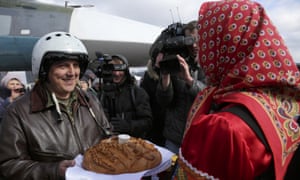
The first pilots arrived back in Russia from Syria on Tuesday, to the strains of bombastic military marches, cheering and a “mission accomplished” vibe provided by breathless state television reporters.
The Syrian adventure, or at least the television portrayal of it, has shown off a new, confident Russian military. Millions of Russians watch nightly bulletins in which their heroic fighter pilots drop precision bombs on terrorist targets, and while there has been no great public enthusiasm for engagement in Syria, it has enhanced the image of the military among Russians, and surprised foreign observers.
“We’d all expected after an initial flurry of activity we’d start seeing planes falling out of the sky or needing repairs. But they managed to keep up a schedule and keep the supply chain functioning. It was classic Russian style: a bit inelegant, a bit ad hoc, but it worked,” said Mark Galeotti, professor of global affairs at New York University and currently based in Moscow.
The patriotic tone and the boasts of mission success have been polished for domestic consumption. There has been a major divergence between the stated goal of fighting Isis and the reality of where in Syria Russia’s bombs have fallen. Additionally, despite official rubbishing of all reports of civilian casualties from Russian officials, human rights groups have claimed that the Russian raids have taken hundreds, and possibly thousands, of civilian lives and in the words of Amnesty International “showed evidence of violations of international humanitarian law”.
There are also questions over whether in the current climate, with the economy stagnating due to sanctions and the falling oil price, Russia could have continued in any case with a lengthy military engagement.
But despite the major caveats, the intervention has shown off a new Russian military that is a far cry from the sorry state of the armed forces just a few years ago.
Over the past two years, the Russian military has been involved in two wars: the clandestine intervention to help separatists in Ukraine, and the very open intervention in Syria.
It all began with the annexation of Crimea in February 2014, when highly professional, well-equipped troops with no insignia fanned across the peninsula to surround Ukrainian army bases and key infrastructure points.
Dubbed “polite people” for their calm demeanour and few words, there was little doubt the men were Russian soldiers, and after initial denials, the Russian authorities later revelled in the deception. Late last year, an image of a soldier and the words “polite people” were even shone on to the outside of the Russian defence ministry building with a powerful laser beam for several weeks.
The differences between the “polite people” and the ragtag collection of troops seen during the brief war with Georgia in 2008 were overwhelming.
“The Georgian war forced our army to look at itself in the mirror, and what we saw wasn’t pretty,” said Viktor Baranets, a retired army colonel, military analyst for Komsomolskaya Pravda newspaper, and former press secretary to the defence ministry. “We thought we were awesome, but it turned out we were ugly, with big spots on our nose and no teeth.”
According to Galeotti, of the total Russian armed forces of about 750,000 personnel, about a third have been reformed, and there are perhaps about 40,000 elite land troops – enough to take Crimea but not necessarily enough for a full-scale land invasion of Ukraine or Syria.
The reforms to Russia’s military began after the Georgian war, during Anatoly Serdyukov’s tenure as defence minister. From a civilian background, Serdyukov immediately went about cutting the huge officer corps and making long-overdue reforms. He remains deeply unpopular in the army hierarchy, and was eventually ousted in a corruption scandal himself, but analysts say his reforms paved the way for the new-look Russian army that has emerged in the past two years.
No comments:
Post a Comment